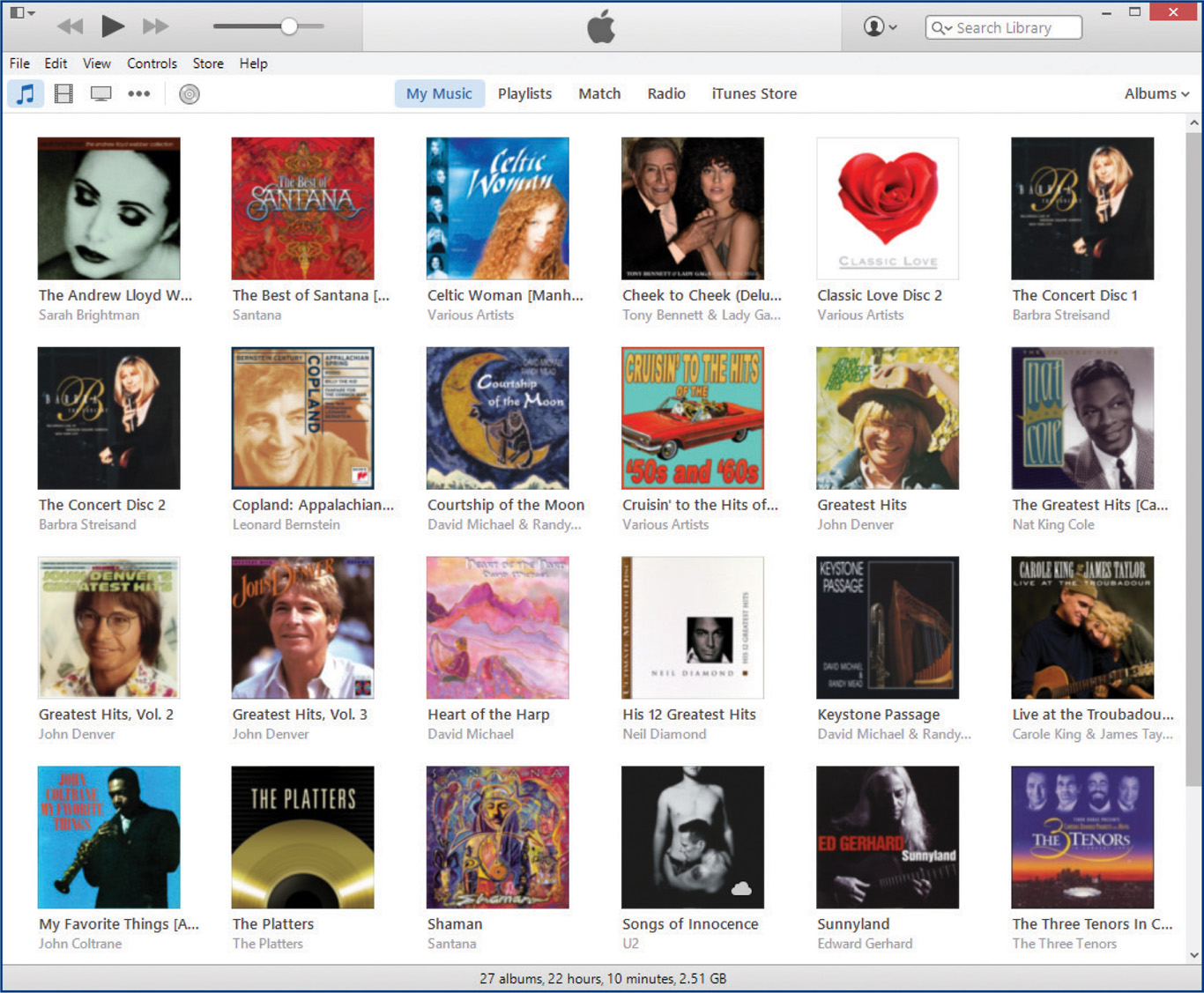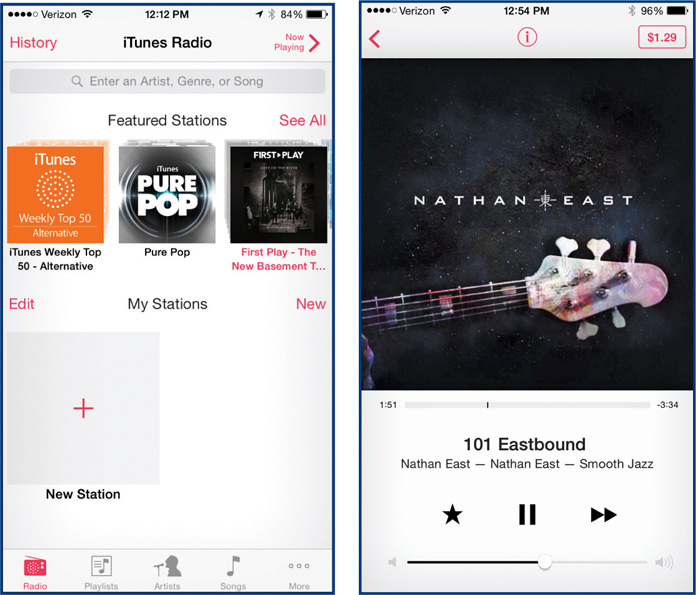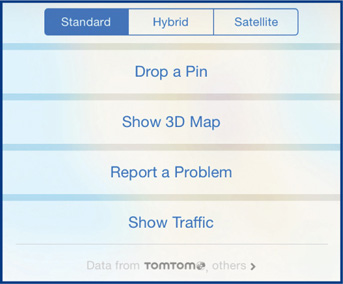Chapter 7
Listening to and Reading on the iPhone
In the first six chapters, I’ve primarily covered how to get the most productive use out of your iPhone. In this chapter, you’ll see how to relax and enjoy your iPhone by locating, getting, organizing, and listening to music and then how to locate, organize, and read electronic books (ebooks) and other documents.
LISTEN TO MUSIC
Music has always been a powerful part of human history, and it remains so in this mobile digital age. People may not agree on the type of music they like, but the majority of people like to listen to some form of it—and the iPhone supports that in spades. Here, we’ll look at getting music from two sources (iTunes and your computer), organizing it into playlists, and then listening to it.
 Get Music from iTunes
Get Music from iTunes
iTunes makes available for purchase and download over 37 million songs. iTunes is easy to use to search, open, preview, and buy music that you want to listen to.
TIP In addition to music, at the iTunes Store you can buy movies, TV shows, and other media. The general discussion here on how to use iTunes applies equally to all the types of media available through it. I talked briefly about getting videos and movies in Chapter 6.
Set Up iTunes
iTunes comes already installed on the iPhone, and using it requires little more than opening it. You must, of course, have an Apple ID, but you most likely have that, as described in Chapter 1. Take a brief look at the iTunes settings by tapping Settings | iTunes & App Stores from the Home screen:
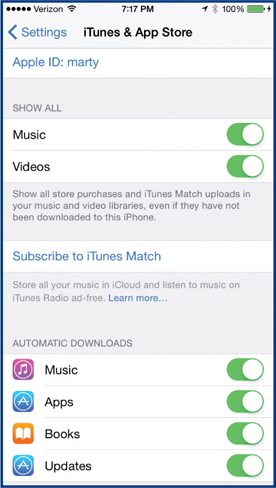
• Show All allows you to determine whether you want to show all of the music and videos you have purchased from iTunes and in iTunes Matches (see next item) as well as whether you have downloaded them to your iPhone. The default is to show them.
• iTunes Match allows you to subscribe (for $24.99 a year) to an iCloud service that stores all of your music, regardless of whether you bought it on iTunes or not.
• The four Automatic Downloads options allow purchases on other devices, such as an iPad, to be automatically downloaded to your iPhone. These are on by default, and under most circumstances, you want to leave them that way.
• If you have a limited data plan, you probably do not want to use cellular for the automatic downloads between Apple devices and for iTunes Match. This is the default, which you probably want to leave.
• Suggested Apps allows you to turn on or off the suggestions on the lock screen and App Switcher of apps that you have installed or are available from the App Store related to your current location. The default is that they are both turned on.
Become Familiar with iTunes
Take a quick look around iTunes and get familiar with the interface. Open it by tapping iTunes Store on the Home screen. The iTunes screen that opens has two sets of selectors. At the bottom of the screen are the primary categories of Music, Movies, TV Shows, Search, and More. For each of the first three categories at the bottom there is a set of genres, or subcategories, available by tapping Genres at the top-left area of the screen.
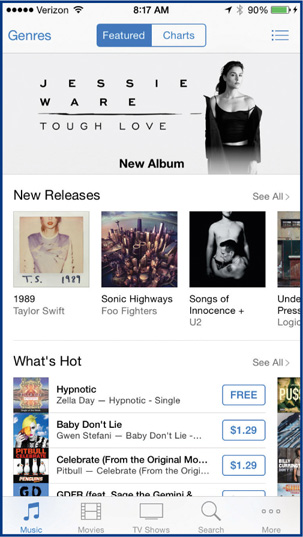
The last two items on the bottom allow you to search iTunes or open five additional sources of music. At the top of the screen, in addition to selecting a list of genres, you can choose between Featured, pieces selected by iTunes (the default), and Charts, pieces selected based on their popularity. Within Charts you can see the most popular singles at the top, followed by albums and music videos. On both the Featured and Charts screens, you can scroll most rows from right to left.

![]()
NOTE As seniors, we may not recognize much of the music that is displayed, but iTunes has our music also.
Search iTunes
The key hurdle in using iTunes, of course, is finding the music you want to buy. iTunes gives you several ways of reviewing what is available.
1. When you first open iTunes, All Genres is selected on the Genres screen. This provides a smattering of recent popular albums and songs of different types.
2. To hone in on a particular genre, tap Genres at the top-left corner to review what is available.
3. Tap several genres that appeal to you, such as Blues, Classical, Jazz, Pop, and Rock, and look at what is available.
4. Tap Search in the bottom-right area to open the Search box at the top of the screen, where you can enter album, artist, and composer names, as well as categories of music. For example, to search for the music of my youth and young adulthood, I entered Music of the 50s and 60s and was amazed at all I got.
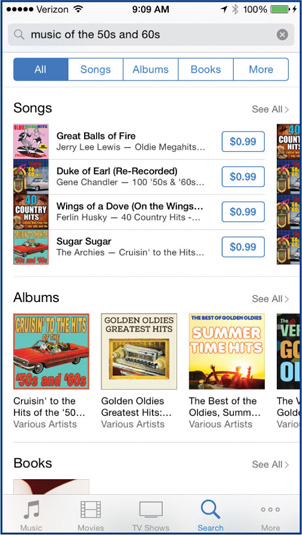
Preview and Buy Music
Once you have found the music you may want, the next step is to preview it and make sure it is what you really want—and, if so, to buy it. To preview and potentially buy an album or song that you have found, follow these steps:
1. From the iTunes page you found earlier—for example, the result of my “Music of the 50s and 60s” search—tap an album or song you are interested in. I tapped Cruisin’ to the Hits of the ‘50s and ‘60s.
2. You get an overview, review summary, price, and list of the songs on the album or just the individual song. Tap any of the songs to have a 90-second preview of it played on your iPhone.
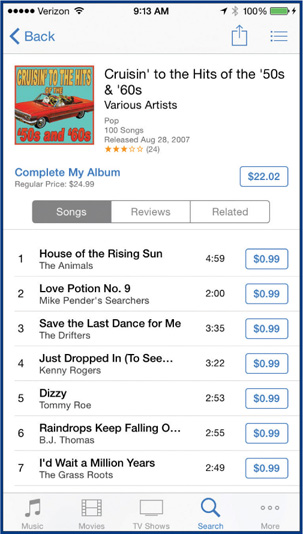
3. When you find a song or album that you want to buy, tap the price, tap Buy Song,
![]() use your Touch ID or enter your Apple ID password, and tap OK. You will see your song downloading, and when it is done, the word “Play” replaces the price.
use your Touch ID or enter your Apple ID password, and tap OK. You will see your song downloading, and when it is done, the word “Play” replaces the price.
![]() The first time you buy something from the iTunes or App Store, you will be asked to agree to Apple’s terms of sale (a 34-page document you can have emailed to you). You are asked this even if the app or song you are getting is free.
The first time you buy something from the iTunes or App Store, you will be asked to agree to Apple’s terms of sale (a 34-page document you can have emailed to you). You are asked this even if the app or song you are getting is free.
 Transfer Music from a Computer
Transfer Music from a Computer
If you have had a computer for any length of time, you probably have put some music on it, either by downloading the music or by copying CDs you have to your computer (called “ripping” CDs). The major way to get music from other iTunes sources to your iPhone is through your computer, and to do that you need to have iTunes installed on your computer. You may already have iTunes on your computer, but if not return to Chapter 1 and install it now; then look at collecting the music you have on your computer, ripping CDs to iTunes, and finally transferring and syncing your music between your computer and your iPhone.
Collect the Music on Your Computer
To get the music from your computer onto your iPhone, it must first reside in iTunes on your computer. In many instances iTunes will automatically find and list the music from your computer if it is in the standard folders, and you will not need to do anything more (see Figure 7-1).
Figure 7-1: iTunes is more than a conduit for communicating between your iPhone and your computer; it is also a great organizer and player of music on your computer.
If iTunes did not automatically locate and list your music, assist it by opening the file system on your computer (Windows or File Explorer on Windows, or Finder on a Mac) and locating your music. On recent Windows computers (7 and 8), it is probably located within Libraries/Music/. On Macs (recent OS X versions), it is probably located within Music. With that knowledge, follow these steps:
1. In iTunes on your computer, the first time you use it, click Scan For Media. This will pick up the easily recognized music. On my computer it picked up most of the 27 albums I have.
2. Still in iTunes on your computer, click File | Add Folder To Library. Navigate to the folder that contains any music not automatically picked up.
3. Click the top album, press and hold SHIFT, click the bottom album to select them all, and click Select Folder.
4. You may be told that one or more of the songs you are adding to iTunes needs to be converted to a different format. Click Convert. The process of converting and adding your music to iTunes may take several minutes, depending on how big your library is.

Rip CDs to iTunes
Here’s how to rip or add music from a CD to iTunes:
1. If it isn’t already, start iTunes on your computer.
2. Place the CD in your computer’s CD drive. iTunes will open, displaying the CD you inserted and its songs.
3. iTunes will ask if you want to import the CD. Click Yes.

![]()
TIP If you don’t want to import the entire CD, you can uncheck the songs you do not want to import.
4. If you are asked about import settings, unless you have a special need, accept the default and click OK.
5. As the CD is being imported, you’ll see the status at the top and a green check mark in a green circle.
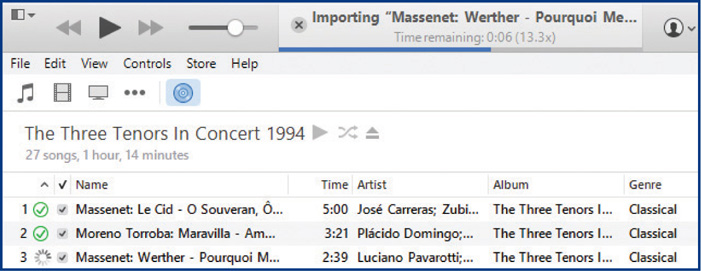
6. If you are told that the cover artwork cannot be found, click OK. You can live without it or come back later and try to find it (do an Internet search on the title).
7. When you are done importing, remove the CD from the computer.
Transfer and Sync to iPhone
You can transfer all or selected parts of the music on your computer to your iPhone automatically by syncing it, in essence making the music on your iPhone the same as the music on your computer.
1. Plug your iPhone into a Universal Serial Bus (USB) port on your computer and unlock the iPhone, if necessary.
2. On your computer, start iTunes, click your iPhone in the objects bar (it should be the object on the left but closest to the center), and click Music under Settings, as you can see in Figure 7-2.
Figure 7-2: iTunes on your computer allows you to have consistent music on both your computer and your iPhone.
3. Click Sync Music and click either Entire Music Library or Selected Playlists. I recommend Selected Playlists to conserve space on the iPhone.
4. Review the playlists, artists, genres, and albums and select (check) the ones you want on your iPhone. Note that the lists duplicate each other. Probably the least confusing is to select albums and not any other category.
5. When you have selected the music you want to transfer, click Apply in the lower-right corner.
Syncing transfers the music that is not currently on your iPhone from your computer to the iPhone, but the opposite is not true—music that’s on the iPhone but not on the computer will not be transferred to the computer.

 Create Playlists
Create Playlists
A playlist is a list of songs from various albums that you want to play together in sequence. Selecting the playlist plays all the songs on it. The process of creating a playlist entails simply selecting the songs you want on the list and giving it a name. Here is how you do it in the iPhone’s Music app:
1. From the iPhone’s Home screen, tap Music | Playlists on the bottom left. If you see Playlists, tap More on the right and then tap Playlists. If you have purchased several individual songs on an album, they will be shown as a playlist under the album’s name.
![]()
NOTE The icons at the bottom of the Music screen can be rearranged according to what you use most often by tapping More | Edit and dragging the icons to where you want them.
2. To create a new playlist, tap New Playlist (the plus sign), type a name, and tap Save.
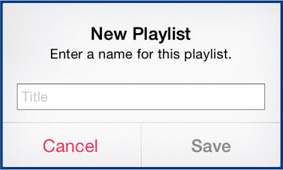
3. Tap Songs at the bottom of the screen. This will open a list of all the songs on all the albums you have either imported from your computer or purchased on iTunes.
4. Either swipe up or use the alphabetic index on the far right to scroll through the list so you can find the songs you want.
5. Tap the songs you want on the playlist. When you have selected all the songs you want, tap Done. The list of songs on your playlist will appear.
6. Tap Edit in the upper left to go into edit mode.
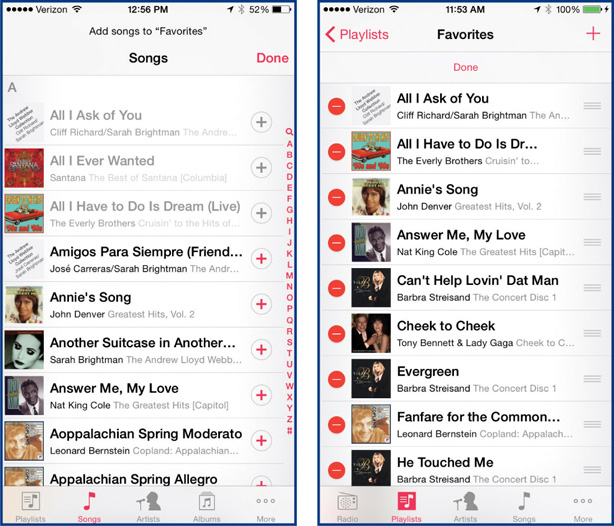
NOTE Only playlists that you create on the iPhone can be edited. Playlists that you bring over from your computer cannot be.
7. To delete a song on the list, tap the white bar in the red circle and then tap Remove. Drag the grip strip on the far right to reposition songs within the list.
![]()
8. To add a song to the list, tap the plus sign in the upper right and repeat steps 3 through 5. When the list is the way you want it, tap Playlists on the left. Your new playlist will appear on Music’s Playlists page.
 Listen to Music
Listen to Music
You can listen to music on your iPhone using iPhone’s Music app, which has a number of features to fulfill that function. Unless it has been moved, the Music icon is on the right end of the dock at the bottom of the Home screen.
![]()
TIP The Music app allows you to play not only music, but also podcasts and audiobooks, as well as listen to “radio” (streaming audio).
To play music on your iPhone from the Home screen, tap Music, tap one of the categories at the bottom, tap Radio, Playlists, Songs, Artists, or More where you find Albums, Genres, Compilations, and Composers, and finally tap an individual song you want to play. The iPhone’s player will open with these controls:
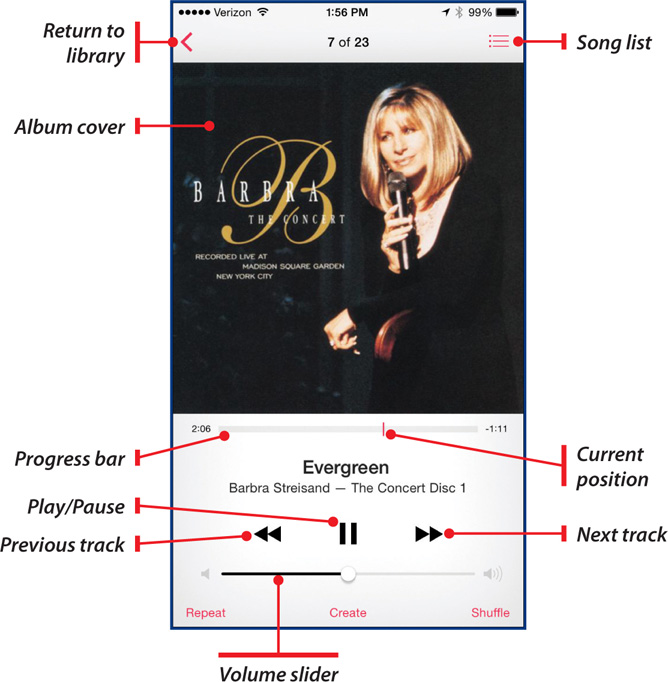
• Return to library (the arrow in the upper-left corner) leaves the current song and returns to the Playlist, Album, or Artist library, but leaves the song playing unless you pause it.
• The song list (the three lines in the upper-right corner) displays the list of songs in the album.

• The current position shows where you are currently in the song that is playing. You can drag the red position marker (also called a “Playhead”) in either direction to move what is currently playing.
• The progress bar provides the span for marking the current position in a song that is playing. The number of minutes already played and remaining are at either end of the progress bar.
• Player controls with Previous and Next allow you to step through an album one track at a time in either direction, and Play and Pause allow you to start and stop playing the current song.
• The volume slider can be dragged left or right to lower or raise the volume of the music being played.
• Repeat repeats the current song.
• Create allows you to create a new playlist or radio station based on the currently selected artist or song.
• Shuffle rearranges the list of songs in an album and plays them in a random order.
![]()
TIP To delete an album from your iPhone, tap More | Albums (unless you have rearranged the icons), swipe the album from right to left, and tap Delete. You cannot delete albums that are on iCloud (for example, the free U2 album Apple gave everyone). To remove it from your iPhone, in Safari go to itunes.com/soi-remove, tap Remove Album, sign in with your ID and password, and you will be told the album is removed.
Control Music
Actually controlling the music you are playing is, at this point, anticlimactic, and you probably have, with the touch controls so obvious, figured it out. This, of course, varies a bit, depending on the view you have on the screen.
1. After tapping the song you want to play, the player will open with the progress bar, player controls, and volume slider, as described previously, and the song will begin. The entire playlist, album, or artist collection will play if you don’t interrupt it.
2. Tap Pause in the player controls to temporarily stop playing the music. Tap Play to start playing again where you left off.
3. Tap Previous or Next to go to the previous or next song or track in the album.
4. Drag the volume slider to increase or decrease the volume.
TIP Some headphones, such as Apple’s EarPods, which can be plugged in on the left of the Lightning USB cable, allow you to adjust the volume remotely on the wire to the headphones.
Set Up Music
Open Music’s settings from the Home screen by tapping Settings | Music. Options include the following:
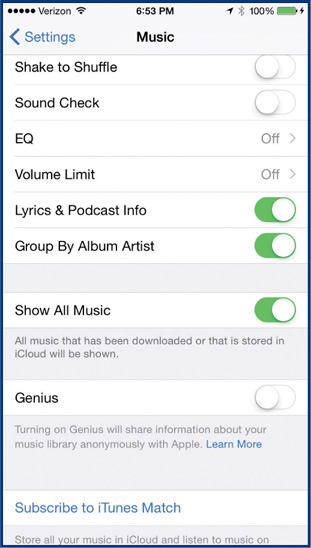
• Shake To Shuffle lets you shake your iPhone to change the order in which songs are played.
• Sound Check, when turned on, levels out volume highs and lows.
• EQ allows you to select preset equalizer settings for various types of music.
• Volume Limit lets you set a maximum volume limit, which you might want to use with headphones.
• Lyrics & Podcast Info provides added information when it is available.
• Group By Album Artist groups albums by one artist together.
• Show All Music provides for the display of all music that has been downloaded to the iPhone or stored on your iCloud account.
• Genius allows Apple to anonymously gather information about your music library so they can suggest similar music to you.
• iTunes Match sets up the storing of all of your music on iCloud, including music you have ripped from CDs and downloaded from other sources. See “Set Up iTunes” earlier in this chapter.
• Home Sharing displays the Apple ID used with Home Sharing.
![]()
TIP Turning the iPhone to Landscape orientation (lengthwise) displays a full screen of your album covers.
Use the Control Center Controls
If you are playing music while also using another app, such as an app for reading a book or magazine, you can quickly get to a set of player controls in the Control Center without having to open the Music app and possibly losing your place in what you are reading.
You can display the audio controls from any open screen on your iPhone by swiping up from the bottom of the screen and using the same player controls described earlier.

 Listen to iTunes Radio
Listen to iTunes Radio
iTunes Radio is a competitor of Pandora and other streaming Internet “radio” stations (where the music is sent to you as you are listening to it). iTunes Radio provides a number of stations either dedicated to particular types or genres of music or groupings of music such as the current top 50 songs or The Beatles Radio. You can also create your own station, which is stored on iCloud, so you can listen to it and any of the other stations anywhere you have iTunes, including your iPhone, iPad, iPod, and your PC or Mac computer.
![]()
NOTE iTunes Radio is itself free, but there will be occasional ads to listen to, and you are reminded that you can buy the current song for your own library by clicking the price associated with it. If you sign up for iTunes Match (explained earlier in this chapter), you will be spared the advertising.
If you have never used iTunes Radio, you may not see the icon at the bottom of the Music screen and you will need to download the app from the App Store. Tap App Store and tap Search on the bottom right of the screen. Tap in the Search box at the top of the screen, type itunes radio, and tap Search. When iTunes Radio appears, tap Listen Now.

If you do see the iTunes Radio icon at the bottom left of the Music screen, tap it. In either case, iTunes Radio will open. Across the top are featured stations, and on the bottom is space for your own selected ones. To use iTunes Radio on your iPhone, follow these steps:
1. Scroll Featured Stations by swiping from right to left.
2. Select a station to listen to by tapping it. The Now Playing screen will open and display the album cover for the current song, as well as the familiar player controls.
3. Tap the info icon for more information about the current song and to create a new station based on the current artist or current song. You can also tune the current station to play only the top hits or a variety of related music, or you can explore some variations of the theme of the current station. Finally, you can choose to allow explicit tracks as well as if and how you want to share this station with others.
4. There are several ways to start a station of your own. As you read in step 3, you can start a new station based on an artist or a song you are currently playing. You can also tap New Station (the red plus sign) on the iTunes Radio page and select a genre and possibly a subcategory. Finally, you can use the search box at the top of the screen and enter an artist, song, or genre.
![]()
TIP If you only have one of your own radio stations, you can see the New Station plus sign on the initial iTunes Radio screen. If you have two or more of your own stations, you will need to scroll up from bottom to top to see New Station.
5. To change or delete a radio station you have created, tap Edit on the left of the My Stations heading. Tap the station you want to work with. You can add artists, songs, and/or genres that you want more of or don’t want to hear. Alternatively, you can tap Delete Station and then tap Delete to remove the station.
READ ON THE IPHONE
Reading on the iPhone is easy, and the iPhone offers a lot to read. Many newspapers are available both in Safari and in their own apps. Also, a large number of magazines, again both online and in their own apps, are available. Then there is the iBook app that comes with iPhone with which you can buy books and read them. Finally, several third-party ebook readers are available in the App Store, along with thousands of free books that you can read, and a great number more that you can buy.
 Read Using Safari
Read Using Safari
A great deal of material to read on the Internet is available directly in Safari without another app, as you have seen in Chapter 3. This includes web pages themselves, blogs (web logs, or ongoing writing about a particular subject), newspapers, and magazines. To read on Safari (for example, The New York Times website), follow these steps:
1. From the Home screen, tap Safari.
2. Tap in the address box at the top center of the screen and then tap the X on the right end of the box to remove its contents.
3. Type nytimes.com and tap Go. The New York Times home page will open.
4. When you see an article you want to read, tap it to open a page with that story.
5. Tap Reader (the stack of lines) at the left end of the address bar. The article will appear in a well-formatted, easy-to-read page.
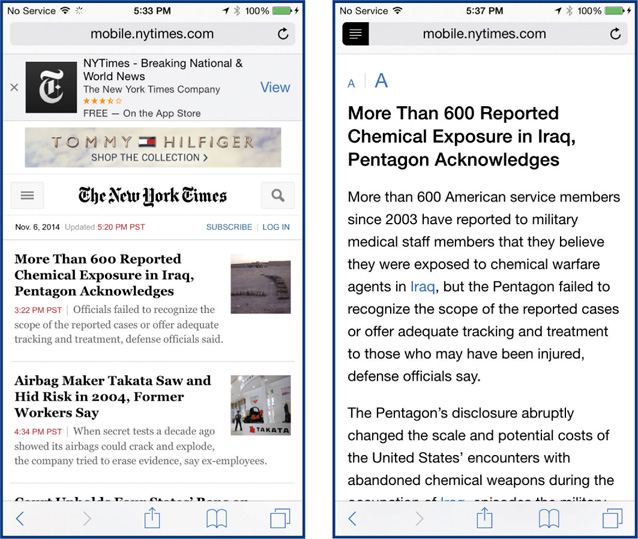
 Read Using the Newsstand
Read Using the Newsstand
The Newsstand is a holder for certain newspapers and magazines whose app has been customized so that the publication goes into the Newsstand (the Newsstand itself is not an app). One such magazine is National Geographic. Here’s how to get and use it:
1. From the Home screen, tap the Newsstand icon to open the Newsstand.
2. Tap Store on the bottom-right corner of the Newsstand. The App Store will open and display several magazines.
3. To locate a magazine you don’t immediately see, tap and clear the search box in the upper-right corner, type the magazine name, and tap Search. A set of magazine apps will appear.
4. Tap National Geographic in either the original set of magazines, if it appeared in step 2, or as a result of the search in step 3.
5. Tap Free, tap Install, and then tap Open. A page opens showing recent copies of the magazine, where you can buy individual issues or subscribe for a year.
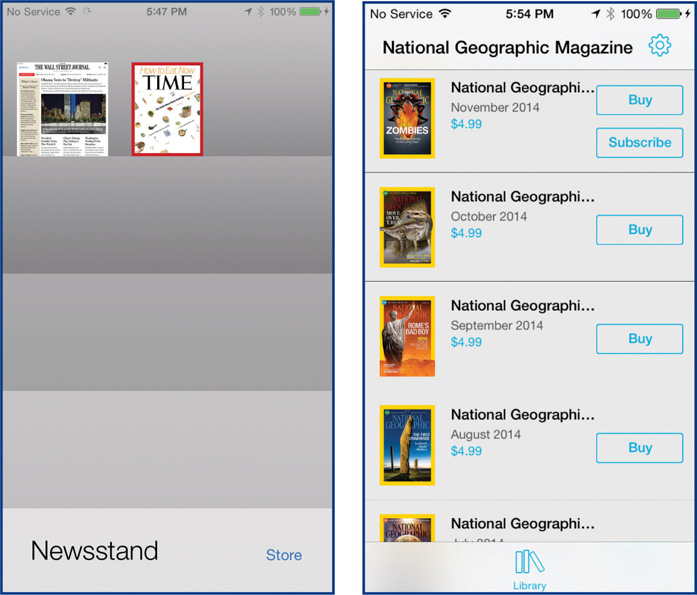
6. Tap your choice, tap Buy, type your Apple ID password, and tap OK. Tap Download. The magazine will download and then be displayed.
TIP Some magazines automatically download new issues and sometimes automatically charge you for that new issue, depending on your subscription arrangement with them. By tapping Settings | iTunes & App Store, you can turn off the Automatic Downloads Updates.
 Read Using iBooks
Read Using iBooks
With iBooks, you can carry a small library around with you; add to that the iBookstore and the iCloud, and you have an endless supply of reading material. The iBooks app is not only a container and organizer for your books, as is Newsstand for magazines, but it is also a reader, a portal to the iBookstore, and a means to fully annotate your books with bookmarks, highlighting, and notes.
Set Up iBooks
Start your iBook experience by setting it up the way you want:
1. Press Home and tap Settings | iBooks to open the iBooks settings.
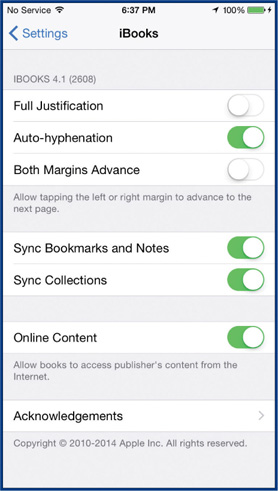
2. Review the settings and consider if you want to change any of them:
• Full Justification, when enabled, aligns the text to the margins on both the left and right edges by spreading out the characters and words. The alternative is to have a ragged right edge with consistent character and word spacing.
• Auto-hyphenation, when enabled, allows splitting words on the right margin to facilitate justification without drastic changes to the character and word spacing.
• Both Margins Advance, when enabled, allows you to advance to the next page on the right by tapping the left margin as well as the right margin. Otherwise, tapping the left margin will take you back one page.
• Sync Bookmarks And Notes and Sync Collections, when enabled, sync your bookmarks, notes, and current page information, as well as the way you have organized your books into collections across your iOS devices such as iPads and iPods.
• Online Content, when enabled, allows the book you are reading to go online and access content from the book’s publisher.
• Acknowledgements is simply Apple acknowledging the people who contributed to iBooks.
3. Press Home to leave Settings.
Search and Buy from the iBookstore
The iBookstore is like the iTunes Store, except that it is for books. Here is how to buy or acquire (some are free) one or more books:
1. From the Home screen, tap iBooks and tap Featured in the bottom-left area. The iBookstore will open.
2. Swipe from right to left the various lines of books. Swipe up to review various categories of books. You might want to explore Categories at the top left or Top Charts at the bottom center. You can also tap Search and enter to search for specific books, authors, or categories.
3. When you find a book you are interested in, tap it to open detailed information about it.
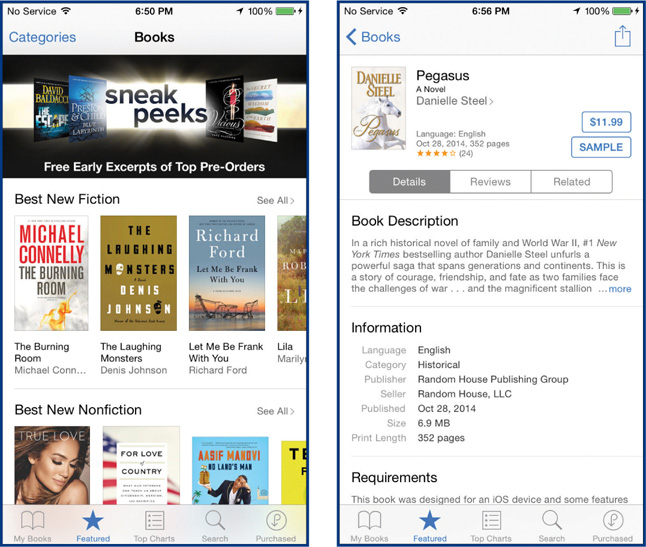
4. If you want to read a sample of the book, tap Sample. The book will appear on your bookshelf with the word “Sample” on the cover. Some samples are quite extensive.
5. When you are ready to buy a book, tap the book’s price and then Buy Book, enter your Apple ID password, and tap Return. The book will appear in iBooks.

Use iBooks
Although the principal purpose of iBooks is to facilitate the reading of books, it also provides for the acquiring, organization, display, and disposal of books. The functions that can be performed in iBooks include the following:
• View books either in the standard bookshelf view, shown next at left, or in a list view, shown next at right by tapping the stack of lines icon in the upper-left corner.
• Sort list view by tapping one of the four sort methods at the top of the list view screen.
• Arrange books on the bookshelf by touching and holding on a book while dragging it to another location.

• Search for a book by scrolling to the top (swiping from top to bottom) of the bookshelf or book list; tapping in the search box; entering the keywords such as author, title, or subject; and tapping Search.
• Delete a book in either view by tapping Select in the far-upper-right corner and tapping the book (or books) you want to delete to place a white check mark in a blue circle on the book(s). When you are ready, tap Delete. You then can tap either Delete This Copy to delete the copy on your iPhone or Delete From All Devices to delete copies from your iPhone as well as any copies on your other iOS devices. Tap Done. The book will remain available to you in iCloud (see the icon in the upper-right corner of the book). Tap the book to bring a copy back onto the iPhone.
• Organize books by putting your library into collections or categories that you set up similar to the categories in list view, but with your own categories (or “collections”) that appear in both Bookshelf and list view. Do this by tapping Select, selecting the books, tapping Move, and selecting the collection or creating a new one.
![]()
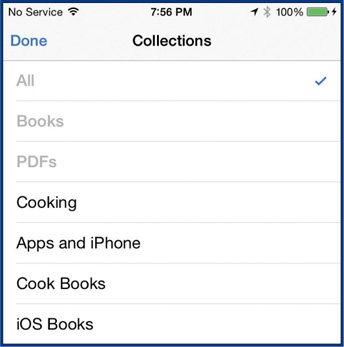
Read a Book
Using iBook to read a book is quite easy, but iBook also provides the means to do much more than just read—in terms of enlarging the page, changing the font size, jumping to a particular page, jumping to the table of contents, looking up the definition of a word, and adding a bookmark. Not all books that you read in iBooks have exactly the same features, but many have the ones described here:
• From iBook, swipe the bookshelf (if needed) to open the collection and then tap the book that you want to read. The book will open. If you have never read any of the book on the iPhone before, it will open to page 1. If you have previously read some of the book on the iPhone or other iOS device with which you are sharing the book, the book will open to where you were last reading.
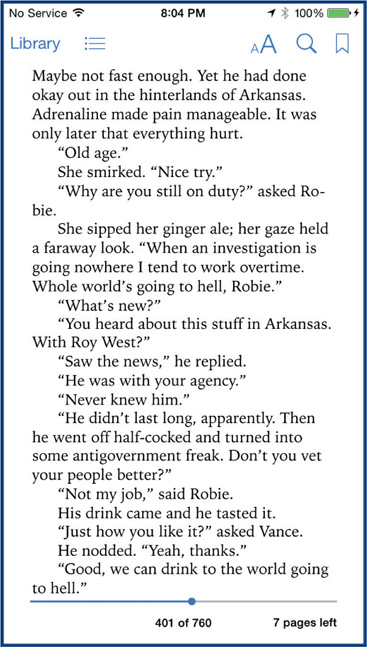
• Turn a page by tapping in the left margin or swiping from the left edge to go back a page, or by tapping in the right margin or swiping from the right edge to go forward a page.
• Display the controls by tapping virtually anywhere on the page (although Apple recommends toward the center of the page).
• Return to the library by tapping the Library button in the upper-left corner.
• Display the table of contents or a list of bookmarks or your notes by tapping the Contents icon and then tapping either Bookmarks or Notes (the Contents page is displayed by default).
![]()

• Change the font and size by tapping the Fonts icon to open the Fonts menu, where you can change the brightness using the slider at the top, decrease or increase the font size by repeatedly tapping the smaller or larger “A,” change the font by tapping Fonts and selecting a font.
![]()
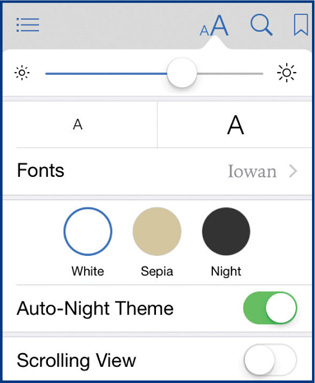
• Search the text by tapping the Search icon to open the Search box. Type a word or page number to search for and tap Search.
![]()
• Add a bookmark by tapping the Bookmark icon on the far right. Tap the icon again to delete it. Because iBook keeps track of where you are currently reading, bookmarks are for other purposes you might have. See a list of bookmarks by tapping the Contents icon and then Bookmarks.
![]()
• Go to another page by dragging the slider at the bottom of the page in either direction.

Annotate a Book
For those who like to annotate the books they read, reading in iBook has to be a real asset. Besides leaving bookmarks, as discussed earlier, you can also perform the following tasks:
• Select text, any amount of it, by double-tapping some of what you want to select and then dragging the endpoints to enclose all of the text you want to select. When you do that, a menu appears that allows you to copy, get a definition, highlight, make a note, search, or share the selection.

• Highlight text by dragging across it or by selecting it and tapping Highlight. In the latter case, in the Highlight menu that opens, tap the color discs on the left and then tap one of the five colors or the underline. Close the highlight menu by tapping anywhere outside of the highlight.

• Add a note by selecting the text to be noted and tapping Note in the selection menu. A blank note will appear, where you can type the note you want. When you are finished, tap outside the note or highlight. The note will disappear, and a little yellow icon will appear in the margin.

• Remove highlight and a note by tapping the highlighted text, tapping Highlight, and tapping the recycle bin. If you have a note, you will be told that the note will also be deleted, and you can tap Cancel or Delete; otherwise, just the highlight will be removed from the text and you are returned to the normal page.

• Search by selecting a word and tapping Search. A search panel opens displaying the locations in the book where the word appears and allowing you to search the Web and Wikipedia.
![]()
TIP Many public libraries, even smaller ones, have programs for lending ebooks on the Internet. You need a library card and a library app such as 3M (used with smaller libraries), OverDrive (which is able to handle multiple library cards), and others. You may be able to choose to get books in different formats. If you choose the Kindle version, it goes through the Amazon store and your device must be registered to your Amazon account. There are differences among libraries on how the ebook lending works, so you’ll need to explore your own local library.
Use Maps
iPhone’s Maps is one of its most useful and practical apps, as well as being fascinating and even fun. You can quickly find where an address is located as well as get directions to it. You can also see where you are currently and get information about that area, as well as find out about points of interest and local establishments. You can see this in a standard map view, in a 3-D view, in a satellite view, or in a hybrid view, where the street names, points of interest, and establishments are overlaid on the satellite view. If that isn’t enough, you can view the satellite and hybrid views straight up and down (so you can better see the streets) or at an angle (so you can better see the buildings). Maps has two primary purposes: to find out where something is located and to get directions to a location.

![]()
NOTE Maps requires an Internet connection, either Wi-Fi or cellular, and voice-driving directions require a cellular connection that will incur data usage. To get your current location you must give permission for that. Although maps are relatively accurate and quite useful, they are not perfect and you must allow for some error.
 Explore Maps
Explore Maps
Maps can be fun to explore, but is also very useful to find out where something is located.
1. From the Home screen, tap Maps. Maps will open and show you where you are currently located with a blue dot in a white circle.
2. You can change what you are seeing:
• Move around a map by dragging it with a single finger.
• Change the orientation of the map by rotating it with two fingers.
• Return to the North at the top by tapping the compass in the upper-right corner, which only appears when you have rotated the map.
• Zoom in by double-tapping with a single finger or by spreading two fingers apart.
• Zoom out by tapping with two fingers or by bringing together two fingers.
3. Search for a location by tapping in the search box at the top of the screen and typing an address; the name or type of an establishment; or a landmark, area, town, city, ZIP code, or region. Maps may suggest a destination as you are typing. If you want the suggestion, tap it.
4. Touch and hold on a location on the map to drop a pin there, identify it, and mark it for future reference. Tap the info icon in the lower-right corner to change the map view, drop a pin in the center of the map, show a 3-D map, report a problem with the map, or show traffic on local streets using increasingly thicker red dashed lines for increasing traffic congestion and yellow dotted lines for construction.
5. Tap one of the many icons on the map to get information about that location or establishment.
6. Tap the arrowhead in the lower-left corner to see your current location.
7. Select Satellite and Show 3D Map on the Info menu to see an awesome view of buildings in that area.
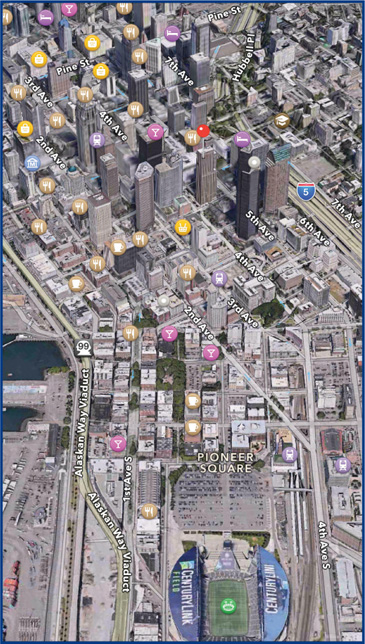
8. Tap the Share menu icon in the upper-right corner to send map information of either your current location or a selected location to others using AirDrop, Message, Mail, or other means.
9. Press the Home button and tap Settings | Maps. Here, you can control the volume of voice navigation, choose whether distance is in miles or kilometers, and whether labels are in English.
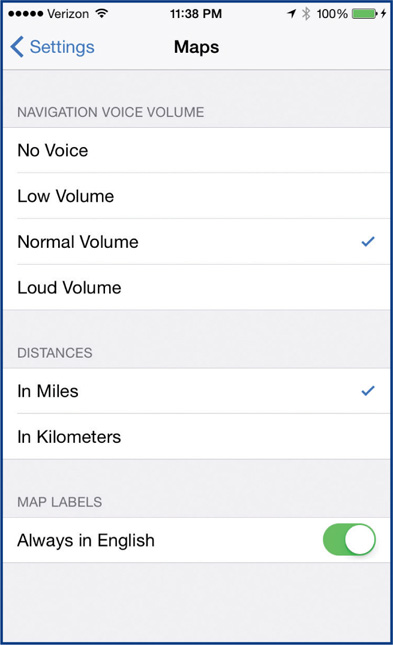
 Get Directions
Get Directions
It is one thing to locate a place or an establishment, but it might still be difficult to get there. Maps can show you how to get to a destination with alternative routes on a map, with a set of written instructions, and can give you turn-by-turn voice instructions.
1. From the Maps screen, tap the Directions icon in the upper-left corner to open the Directions menu.
![]()
Alternatively, you can open Directions by tapping the automobile symbol on a pin you dropped or that appears when you touch and hold on a map feature or the map itself. You can also tap Directions To/From Here in information drop-downs.
2. At the top of the Directions menu, select whether you want directions for driving or walking, or to use third-party apps for directions.
3. Enter or select the starting and ending locations and then tap Route to display the route on the map. The recommended route will be shown in dark blue, while alternative routes will be shown in lighter blue with the approximate driving times shown with each route.
4. Start getting voice directions by tapping Start at the bottom center. The voice directions will begin and then pause until Maps detects you have completed that step. You can stop the voice directions by tapping End in the upper-left corner, change the volume by tapping the loudspeaker in the lower-right corner, or display written directions by tapping List Steps in the bottom middle of the screen.
5. Tap Overview in the upper-right corner of the voice direction map page to expand the map and see the full route.


